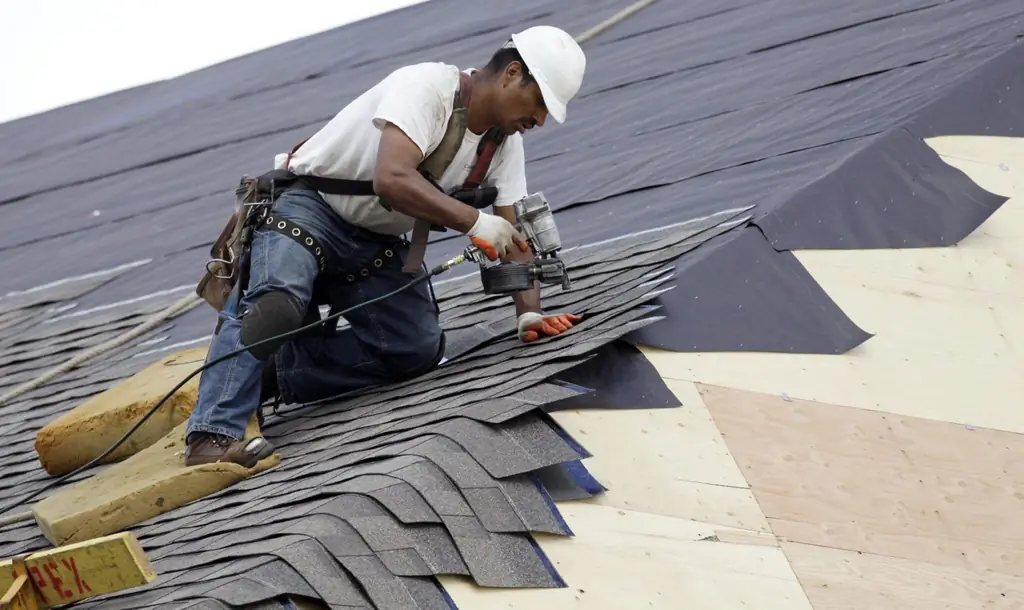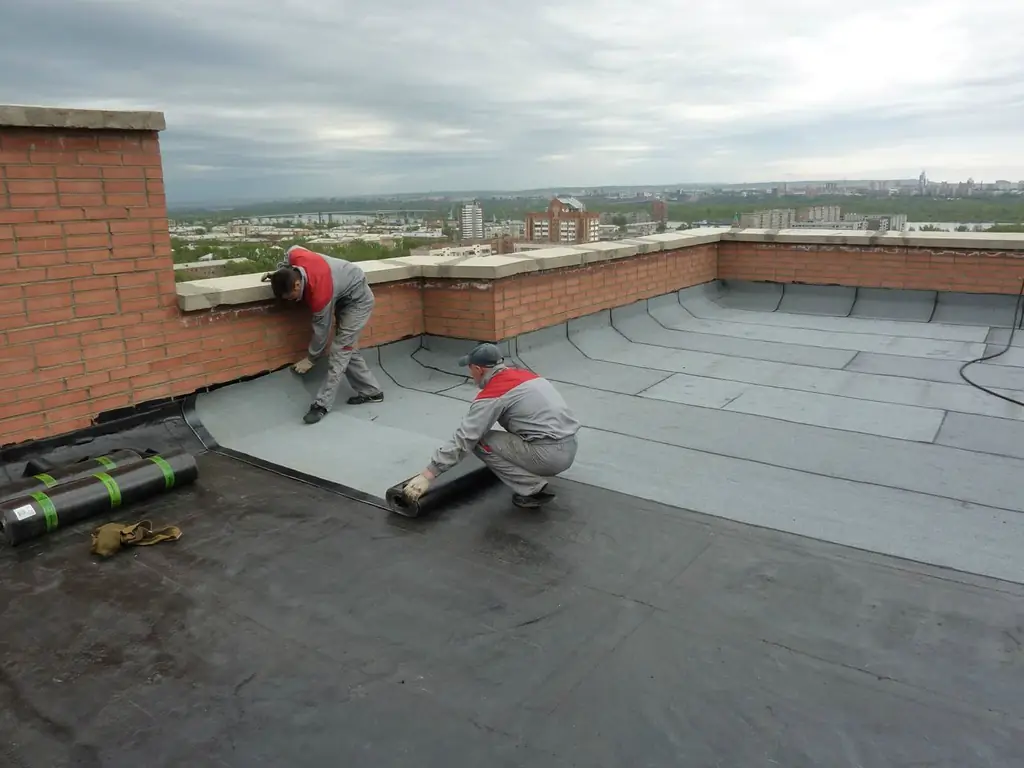
Table of contents:
- Author Bailey Albertson [email protected].
- Public 2023-12-17 12:53.
- Last modified 2025-06-01 07:32.
Features and roof insulation with polyurethane foam: your home is warmly protected

For roof insulation, materials with a different structure are used, depending on this, the installation technology is also selected. A thermal insulator such as polyurethane foam allows for maximum protection of the roof from heat loss, as well as maintaining the operational characteristics of the building. For this, knowledge of installation technology and properties of polyurethane foam is important.
Content
-
1 Polyurethane foam: description and characteristics of the material
1.1 Advantages and disadvantages
-
2 Insulation of the roof from the inside with polyurethane foam
- 2.1 Preparation for insulation
- 2.2 The main stages of thermal insulation
- 2.3 Video: roof insulation with polyurethane foam
- 3 Features of operation
Polyurethane foam: description and characteristics of the material
The composition of the polyurethane foam contains about 85% of an inert gas mass, and the initial components are polyisocyanate and polyol. These ingredients are petrochemical products supplied in a liquid state. During application, these components are mixed in a special container under high pressure and the effect of the optimum temperature. In this case, water is added, which leads to the formation of carbon dioxide. As a result, the composition foams, and after being applied to the surface, the polyurethane foam hardens, preserving the air structure.

The mixture is applied to the surface using special equipment
The liquid structure of polyurethane foam in cylinders makes it easy to apply the composition by spraying. The mixture is supplied in two cylinders, the liquids of which are combined in the spray hose and turn into foam. Thus, the insulation is a tool that resembles polyurethane foam, but has much higher technical characteristics. In this case, the composition is classified into several types, depending on the density. Thus, polyurethane foams can be of the following types:
- rigid with a density of 30-86 kg / m 3 has a structure with closed gas-filled cells and is suitable for thermal insulation of the foundation;
- semi-rigid has a density of less than 30 kg / m 3 and open cells, absorbs moisture and requires additional vapor and waterproofing;
- the density of liquid polyurethane foam is less than 20 kg / m 3 and the material is optimal for filling voids and niches.

Polyurethane foam can be easily sprayed onto the roof surface
Polyurethane foams of various types are characterized by several common features that fully describe the features of the material. A medium density heat insulator used for roofing has the following properties:
- thermal conductivity is 0.019-0.035 W / m K;
- water vapor permeability is 50 according to ISO / FDIS 10456: 2007 (E);
- water absorption is 1-3% of the total volume;
- density determines the flammability of the material. For roofs, polyurethane foam has medium flammability;
- warranty period of operation - 30 years;
- when heated to 500 ° C, the structure releases harmful substances;
- after application, polyurethane foam polymerizes and is absolutely harmless to humans.

Polyurethane foam is suitable for insulating any surfaces
Advantages and disadvantages
Polyurethane foam is used for thermal insulation in the form of a spray mixture or prepared and cured boards. The first option is the most relevant and therefore some advantages of polyurethane foam can be distinguished in comparison with such heaters as mineral wool, penoplex and other options. The main positive features of the sprayed heat insulator are expressed in the following:
- simple installation technology involves spraying the product on the insulated surface. At the same time, all cracks and microcracks are carefully insulated, heat leakage from the inside of the room is prevented;
- the weight of the hardened polyurethane foam is minimal due to the airy and porous structure of the material. This eliminates a significant load on the structure;
- high adhesion distinguishes the composition from other heaters. Polyurethane foam adheres well to surfaces of any material;
- the heat insulator is not subject to decay, corrosion, cracking, mold development and rodents;
- the insulation can withstand temperature extremes and can be operated under conditions from -150 ° to +150 ° C;
- the structure of polyurethane foam excludes cold bridges, since the liquid composition envelops the desired surfaces well.

Polyurethane foam penetrates into all cracks and eliminates heat leakage from inside the room
Disadvantages also characterize polyurethane foam and are taken into account when choosing the optimal insulation option. The main disadvantage of the heat insulator is that ultraviolet rays have a detrimental effect on the structure of the material. To do this, after installation, polyurethane foam needs additional finishing, which protects the insulation from destruction.

Rigid polyurethane foams are particularly susceptible to UV damage.
Certain difficulties are caused by the need to use special equipment for application. The set of devices consists of two cylinders with substances from which hoses are diverted, connected into one and attached to the spray device. The cost of professional equipment is very high, but the equipment can be rented. And it is also worth considering that the structure has a low vapor permeability, which is especially important for a rigid type of material. As a result, the walls under the insulation and interior decoration are exposed to rotting.
Insulation of the roof from the inside with polyurethane foam
The use of polyurethane foam for roof insulation can be carried out outside or inside the roof. In the first case, it is important to take into account the weather conditions, namely the absence of wind, positive air temperature, and absence of precipitation. Such conditions rarely develop and therefore most often they carry out insulation from the inside, for which only a positive temperature under the roof is important. In this case, insulation can be carried out on the roof from the inside or on the roof and floor of the attic. The greatest effect is achieved in the second case, as a large area is covered with polyurethane foam, all joints of walls and roofs are sealed, but more material is needed than when insulating only the roof.

The liquid composition is evenly distributed during application
Preparation for insulation
Basic surface preparation for thermal insulation involves cleaning from dust and dirt, removing excess protruding parts (nails, screws, etc.), and drying. You can also pre-coat the wooden parts of the rafters with an antiseptic, which will prevent rotting and extend the life of the roof. If the old roof is insulated, then all finishing and insulation components should be removed, leaving just the rafter system.

The roof from the inside should not have rotten parts, which will make high-quality insulation
The main stages of thermal insulation
After preparing the floor surface and roof of the attic, set up the spray equipment. The composition must be accompanied by detailed instructions for mixing the components, and all actions are carried out taking into account this manual. The further complex of works involves the following actions:
-
On cylinders, open the taps and press the trigger of the spray gun. A foaming compound begins to flow from the hose.

Equipment for spraying polyurethane foam Polyurethane foam components are supplied in drums to which the equipment is attached
-
You need to apply the product from the farthest bottom corner of the roof. When processing walls, installation is carried out from the bottom up. In any case, the gun should be kept at least 25 cm from the surface to be insulated. The jet is not moved too quickly, smoothly and accurately, which avoids splashing and distributes the mixture evenly.

Application of polyurethane foam on the roof of the building Windows must first be covered with foil, as for other parts of the attic, for example, pipes
-
When moving to a new spraying location, turn off the gun and change the nozzle, and then start treating a different area. The second layer is applied only after complete polymerization of the initial layer of the substance. The average insulation thickness should be 25-30 mm. The insulation should not protrude beyond the crate.

Polyurethane foam on the floor of the attic of a residential building Insulation of the attic floor is carried out in the same way as the processing of the roof from the inside
-
After hardening, the polyurethane foam should be trimmed at the joints and to achieve evenness with the crate, cutting off the excess pieces. Further, the surface is reinforced with a special mesh and corner elements, which are purchased together with the heat-insulating composition. Finishing work is carried out only after reinforcement, which will protect the thermal insulation layer from deformation.

Insulation of the roof of the house with polyurethane foam After insulation, you can carry out finishing
Video: roof insulation with polyurethane foam
Features of operation
A layer of polyurethane foam insulation is easy to apply and carefully hides all the cracks, providing good thermal insulation. The service life of such a material is from 30 years, manufacturers ensure the quality of the coating for 50 years or more. To increase this indicator, it should be borne in mind that inside the attic, processing can be carried out with an open-cell type of polyurethane foam. For open outer surfaces, such a material is categorically unsuitable and deteriorates very quickly.

For external insulation, a closed-cell type of polyurethane foam is used and further finishing is carried out
When working with this insulation, it is worth considering several important rules:
- do not apply a layer more than 20 mm thick in one pass;
- installation is carried out at an air temperature of at least 0 ° C;
- the equipment must work efficiently and have high pressure;
- polyurethane foam is destroyed by the influence of alcohol, acetone, styrene, hydrochloric acid, carbon tetrachloride, ethyl acetate;
- PU foam is not applied to polyethylene and materials based on it, as they have zero adhesion to this insulation.
Polyurethane foam is practical in operation, but requires competent and high-quality installation. The effectiveness of the insulation layer and its durability depend on this. Follow the instructions and you will succeed!
Recommended:
Insulation Of The Roof From The Inside With Foam: Description And Characteristics Of The Material, Installation Stages + Video And Reviews

How to choose foam for roof insulation. How to properly form a roofing cake. Styrofoam stacking and cutting methods
Insulation Of The Roof From The Inside With Mineral Wool: Description And Characteristics Of The Material, The Main Stages Of Installation

Features and characteristics of types of mineral wool. How to choose a roof insulation. How to properly equip a roof with mineral wool
Repair Of A Soft Roof, Including A Description Of Its Main Stages, As Well As Material And Tools For Work

Diagnostics of the condition of the soft roof. Repair types and their main features. A brief overview of roofing materials and recommendations for their selection
Flat Roof Repair, Including A Description Of Its Main Stages, As Well As Material And Tools For Work

A brief description of the types of flat roof repair. Recommendations for the selection of roofing materials. Technology for eliminating various defects on flat roofs
How To Cover The Roof With Roofing Material, Including With Your Own Hands, As Well As A Description Of The Main Stages Of Installation

Appointment and features of roofing material. How to lay material on the roof and step-by-step instructions for work, as well as laying rules for a wooden roof
